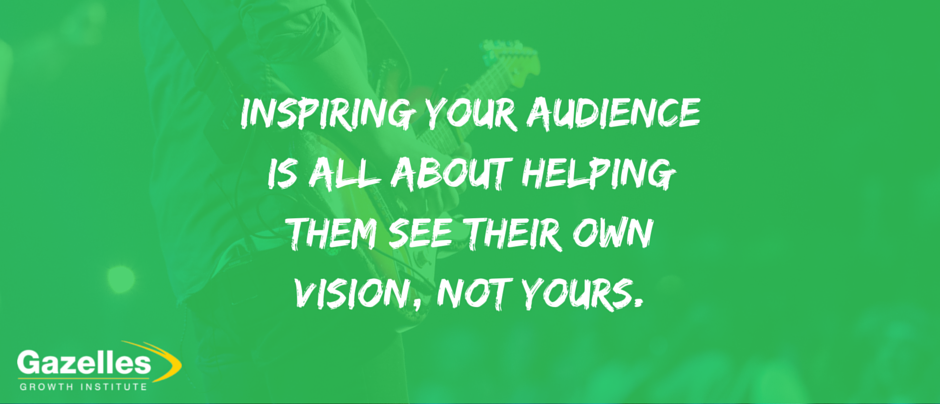It's Not About You: 4 Steps To Inspire Your Audience

Dave Kerpen: An excerpt from his new book, The Art of People: 11 Simple People Skills That Will Get You Everything You Want.
“Why the hell am I so nervous?” I wondered.
It was moments before I would get up to speak to an audience of three thousand people in Mexico City at an entrepreneurship conference. But despite the many people who would be hanging on my every word, I wasn’t sure why I so nervous. Usually, the larger the crowd, the more excited I got, not the more nervous.
Right before I took the stage, my entrepreneur/speaker/author friend Mike Michalowicz, who was up after me, approached me. I thought he could sense my nerves.
“Big crowd, eh?’ Mike said. I nodded in agreement, and then Mike shared with me an important lesson that has stuck with me ever since.
“Remember,” he said. “It’s all about them, not you. Inspiring your audience is all about helping them see their own vision, not yours.”
This may seem simple, but it’s absolutely critical advice for anyone trying to inspire your audience, whether it’s from the stage at a large conference; in a meeting with a boss, team, or department; on a client pitch or sales call; or at home with one’s spouse and kids. The bottom line is that like or not, people don’t really care about you, certainly not the way they care about themselves, their families, and their close friends. Think about it: You’re reading this article so that you can improve your communication and people skills as a professional, but you don’t really care about me, Dave, except for how I can help you. And that’s okay!
Whether you’re speaking to an audience of three thousand, three hundred, thirty, or three, if your hope is to inspire them, your material and delivery have to be about them and how they can grow, not about you.
This doesn’t mean you can’t tell stories about yourself, share things you’ve learned, or talk about your products, services, features, and benefits. All those things are fair game and often are very helpful in delivering an inspiring presentation; storytelling in particular is a great way to make a lesson or message come alive. But as you tell stories, do a product demo, or talk about your company, it’s essential that you paint a picture of what your audience’s life looks like now and what they want it to look like in the future Even more important, it’s essential to show how whatever you’re selling—whether it’s a product, idea, message, or pure inspiration—fits in with their vision of a better future.
People like hearing success stories. But you know what they like more? Their own success stories. If you want to inspire (and perhaps sell something along the way), you’ll want to get people thinking about themselves and their future selves.
It’s easy to get caught in the trap of thinking it’s about you or your product. If you’re a salesperson or an entrepreneur or a leader of any kind, the spotlight is often on you and/or the product you sell. But no matter how much the spotlight is on you, it’s essential to stay humble and keep the conversation about the other person or people in the room, not about you.
This is especially valuable as both a mindset and a tool in creating presentations. For instance, if you’re doing a sales presentation, the slides should remind your audience what their problem is and how your solution will alleviate it. It should help them imagine and even envision life without that problem.
Even if you’re not a public speaker by profession, you're probably still in business to inspire your audience in one area or another. Certainly, all salespeople and marketers are. Entrepreneurs, engineers, and designers need to inspire with their products. Anyone who’s a manager needs to inspire her team to be more productive. Even parenting is all about inspiring one’s children. Whenever you aim to inspire, it’s helpful to remind yourself that it’s not about you.
When Mike Michalowicz shared that lesson with me, it was perfect timing. I was about to tell my story to three thousand people, and although I’m sure they would have found it interesting, I’m happy he said what he did, because not only did he put me at ease, he helped shape a much better keynote speech. Instead of making it about me, I made the entire speech about my audience, mostly entrepreneurs, and how they could grow their businesses.
Today, whether I’m speaking to thousands of people or just a few, I often say those words to myself right before it’s time to present: “It’s not about you.”
FAST First Action Steps to Take:
- Write down the names of the people you want to inspire at work and at home.
- For all those people, write down what you think their vision of themselves is in six months, one year, and three years. If you’re not sure, ask them.
- The next time you prepare to speak to them, remind yourself what their vision of themselves is and how whatever you are selling can help them achieve that vision. Then use that to frame your remarks.
- Every time you speak or present to a new audience, remember that, it’s not about you!
Above was an excerpt from my new book, The Art of People: 11 Simple People Skills That Will Get You Everything You Want, out now. Order your copy here!



